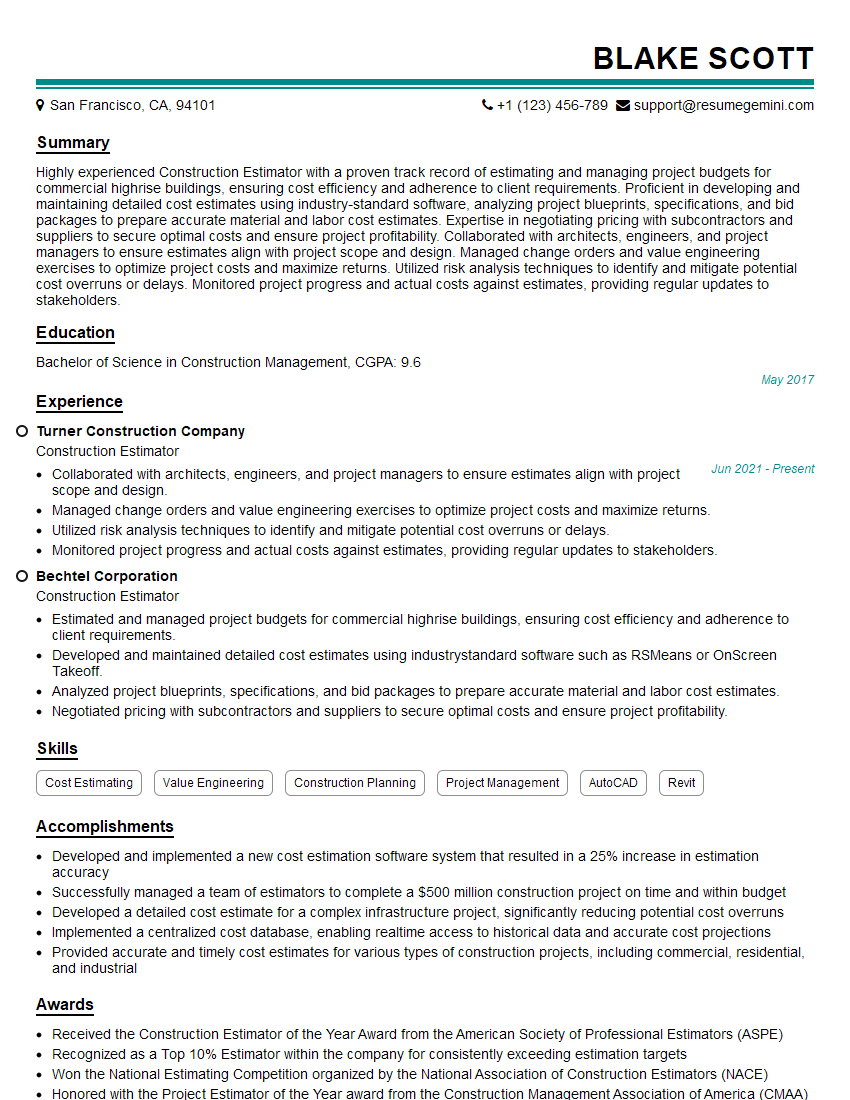The right preparation can turn an interview into an opportunity to showcase your expertise. This guide to Fixture Unit (FU) Calculations interview questions is your ultimate resource, providing key insights and tips to help you ace your responses and stand out as a top candidate.
Questions Asked in Fixture Unit (FU) Calculations Interview
Q 1. Define Fixture Unit (FU) and its significance in plumbing design.
A Fixture Unit (FU) is a standardized unit of measurement used in plumbing design to represent the relative demand a plumbing fixture places on the drainage system. It essentially quantifies the water flow rate and volume a fixture is expected to generate. Its significance lies in simplifying the design process. Instead of dealing with complex flow calculations for each fixture individually, we use FUs to estimate the overall drainage system’s capacity needed, ensuring adequate sizing of pipes and preventing issues like backups or slow drainage.
Q 2. Explain the different types of fixture units (e.g., water closet, lavatory, shower).
Different plumbing fixtures have varying FU values reflecting their water usage characteristics. For example:
- Water Closet: A water closet (toilet) typically ranges from 3 to 6 FUs, depending on the type (e.g., standard, dual-flush). High-efficiency models may have lower FU ratings.
- Lavatory: Lavatories (sinks) usually range from 1 to 2 FUs, depending on the faucet type and flow rate.
- Shower: Showers commonly range from 2 to 4 FUs, varying based on the showerhead type and flow rate. Larger showerheads or multiple showerheads increase the FU rating.
- Bathtub: Bathtubs typically range from 2 to 4 FUs, based on the faucet type and whether it’s a combination tub/shower unit.
- Laundry Tub: Laundry tubs usually have a FU rating of 2.
These are typical values, and specific manufacturers’ specifications should always be consulted for precise FU ratings of their products.
Q 3. How do you determine the demand load for a plumbing system using Fixture Units?
Determining the demand load involves summing the FU values of all fixtures within a plumbing system. This total represents the maximum anticipated flow rate the system must handle. However, it’s important to remember that the actual simultaneous use of all fixtures is unlikely. Therefore, demand factors or reduction factors are often applied to account for this reality. These factors are typically provided by plumbing codes and vary based on the number of fixtures and the type of building.
Example: A building has 2 water closets (6 FUs each), 3 lavatories (2 FUs each), and 1 shower (3 FUs). The total FU is 6 * 2 + 2 * 3 + 3 = 21 FUs. Applying a demand factor (let’s say 0.8 from the local code) results in a design demand of 21 FUs * 0.8 = 16.8 FUs. This value is then used to size the drainage pipes.
Q 4. What are the typical values of Fixture Units for various plumbing fixtures?
Typical Fixture Unit values (FUs) vary depending on the fixture type and manufacturer. However, here’s a general guideline:
- Water Closet: 3 – 6 FUs
- Lavatory: 1 – 2 FUs
- Shower: 2 – 4 FUs
- Bathtub: 2 – 4 FUs
- Laundry Tub: 2 FUs
- Kitchen Sink: 2 FUs
- Dishwasher: 1 FU
- Garbage Disposal: 1 FU
Remember that these are approximate values. Always check local plumbing codes and manufacturers’ specifications for the most accurate and up-to-date FU ratings.
Q 5. Describe the process of calculating the total Fixture Units for a residential building.
Calculating the total Fixture Units for a residential building involves a systematic approach:
- Identify all fixtures: List every plumbing fixture in the building (toilets, sinks, showers, tubs, etc.).
- Assign FU values: Assign the appropriate FU value to each fixture based on manufacturer specifications and local plumbing codes.
- Sum the FUs: Add up the FU values of all fixtures to obtain the total number of Fixture Units for the building.
- Apply demand factors: Consult your local plumbing code to determine the appropriate demand factor for the calculated total FUs and apply the reduction accordingly.
- Verify compliance: Ensure the final total complies with local codes and regulations.
Example: A house has 2 toilets (6 FUs each), 3 lavatories (2 FUs each), 1 shower (3 FUs), and 1 bathtub (3 FUs). The total is 12 + 6 + 3 + 3 = 24 FUs. If the code requires a 75% demand factor, the design demand would be 24 * 0.75 = 18 FUs.
Q 6. Explain how to calculate the drainage pipe size based on Fixture Units.
Drainage pipe sizing is directly related to the total Fixture Units. Plumbing codes provide tables or charts that correlate the total FUs to the required pipe diameter. These tables consider factors like flow velocity and slope to ensure proper drainage without causing backups. Essentially, a higher number of FUs requires a larger diameter pipe to accommodate the increased flow. It’s crucial to consult local plumbing codes for the specific sizing tables as they vary by region.
Example: If the calculated design demand from the previous example is 18 FUs, a reference table in the local plumbing code would indicate the minimum acceptable diameter for the main drain pipe (e.g., 4 inches). Branch lines would be sized according to their respective loads.
Q 7. How do you account for future expansion when calculating Fixture Units?
Accounting for future expansion is essential to avoid costly renovations later. When calculating Fixture Units, consider potential future needs such as adding bathrooms, appliances, or other fixtures. A common approach is to increase the initial FU calculation by a certain percentage, typically 10-20%, depending on the anticipated future growth. This ensures the plumbing system has the capacity to handle the increased demand without needing significant upgrades down the line. It’s always wise to overestimate slightly when dealing with plumbing, particularly in commercial or high-density residential projects where expansion is more likely.
Q 8. What are the factors influencing the selection of the appropriate drainage piping size?
Selecting the appropriate drainage piping size hinges on effectively managing the wastewater flow from all connected fixtures. Several key factors play a crucial role in this decision. First, the total number of fixture units (FU) directly impacts the required pipe diameter. A higher FU count necessitates a larger pipe to prevent backups and ensure efficient drainage. Second, the anticipated peak flow rate, which considers simultaneous use of multiple fixtures, significantly influences pipe sizing. Third, the building’s configuration and the length of the drainage lines are also critical; longer runs require larger pipes to compensate for friction losses. Fourth, the slope of the drain lines is a key factor; a steeper slope allows for faster drainage, potentially permitting the use of a smaller diameter pipe. Finally, local plumbing codes dictate minimum pipe sizes and slope requirements, which must always be adhered to.
Example: Imagine a residential bathroom with a toilet (FU=3), a sink (FU=1), and a shower (FU=2). The total FU is 6. A simple calculation (using a relevant plumbing code table) would indicate a necessary pipe size based on the 6 FUs and local code minimum slope. A longer run for the same fixtures would demand a larger pipe size to account for frictional losses.
Q 9. What are the limitations of using the Fixture Unit method for plumbing design?
While the Fixture Unit (FU) method offers a convenient and standardized approach to plumbing design, it has certain limitations. Its primary weakness is its simplification of complex hydraulics. The FU method assumes a consistent flow rate throughout the system, failing to capture the nuances of simultaneous fixture usage and varying flow patterns. The method also doesn’t always accurately reflect the impact of specific fixture types or unique building configurations. Another limitation is that FU calculations don’t directly account for vent sizing, which is crucial for preventing sewer gases from entering the building. For instance, the method might underestimate the required pipe size in situations with many fixtures located far from the building’s main stack. Finally, the reliance on average values in FU tables might lead to oversized or undersized pipes if those average values don’t accurately represent the actual fixtures in a project. This can result in increased costs (oversizing) or potential plumbing issues (undersizing).
Q 10. How do local plumbing codes impact Fixture Unit calculations?
Local plumbing codes significantly influence Fixture Unit calculations by setting minimum pipe sizes, slopes, and even the FU values assigned to various fixtures. Codes differ across regions and jurisdictions. A specific code might prescribe a minimum pipe diameter based on the calculated FU, overriding any size that might seem suitable based on a general calculation. Furthermore, codes often include specific requirements for vent sizing, which is not directly calculated through the FU method but is intimately tied to the drainage system design. Ignoring these codes can lead to design failures, permit denials, and liability issues.
Example: One locality might mandate a minimum 2-inch diameter drain line for any bathroom with more than 4 FUs, regardless of the calculated flow rate based on the FU method. Another code might use a different FU value for a specific fixture type compared to a neighboring jurisdiction.
Q 11. What are the differences between the methods used for calculating Fixture Units in residential versus commercial buildings?
While the fundamental principles of FU calculations remain the same across residential and commercial buildings, there are notable differences in application. Residential calculations tend to be simpler, dealing with fewer fixtures and often employing standardized FU values from readily available tables. In contrast, commercial buildings present greater complexities, involving a much larger number of fixtures, more diverse fixture types (such as commercial dishwashers or high-flow urinals), and varying usage patterns. Commercial applications may involve more sophisticated hydraulic modeling software to account for these complexities and peak demand scenarios. Furthermore, commercial building codes often impose stricter requirements regarding pipe sizing and drainage design, demanding more detailed calculations and potential adjustments to the basic FU method.
Q 12. How do you handle different fixture types with varying flow rates within a single calculation?
Handling varying flow rates within a single calculation involves assigning appropriate FU values to each fixture based on manufacturer data or established plumbing code tables. Each fixture’s individual FU value is then summed to obtain the total FU count for the drainage system segment. It’s crucial to be precise when selecting these values, as incorrect FU assignments will directly impact the accuracy of the sizing calculations. For instance, a high-flow kitchen faucet might have a significantly higher FU value than a standard bathroom sink.
Example: Consider a kitchen with a sink (FU=1), a dishwasher (FU=4), and a garbage disposal (FU=2). The total FU for this segment is 7, requiring a suitably sized drain pipe to accommodate the combined flow rates.
Q 13. Describe the role of the fixture unit in determining the appropriate sizing of water supply lines.
The fixture unit plays a vital role in water supply line sizing by providing a standardized measure of the water demand from each fixture. The total FU for a particular area (e.g., a bathroom group) indicates the total water flow expected. Plumbing engineers and designers then use this information, in conjunction with pressure drop calculations and local plumbing codes, to select appropriately sized supply pipes that can deliver the needed water volume at sufficient pressure to all fixtures. Undersizing the supply lines could lead to low water pressure, while oversizing increases costs unnecessarily.
Q 14. How do you address the impact of multiple plumbing fixtures sharing a common drain line in your calculations?
When multiple fixtures share a common drain line, the total FU for all connected fixtures must be summed to determine the required pipe size. The calculation considers the combined wastewater flow from all fixtures connected to that shared line, rather than treating each fixture independently. Simply adding the FU values together overestimates the potential for simultaneous peak flow. It’s crucial to utilize appropriate plumbing code tables or hydraulic modeling software to accurately determine the necessary pipe size for this combined flow, taking into account factors like fixture location and pipe length. This ensures adequate capacity to prevent drainage backups and comply with local code requirements.
Q 15. Explain the concept of demand factors in Fixture Unit calculations.
Demand factors in Fixture Unit (FU) calculations represent the probability that all fixtures in a plumbing system will be used simultaneously. It’s unlikely that every toilet, sink, and shower in a building will be in use at the same instant. Demand factors account for this reality, reducing the overall design flow rate to a more realistic and cost-effective level. They are expressed as decimal values (e.g., 0.6, 0.8) and are applied to the total FU count of a specific category of fixtures (like lavatories or water closets). For example, a building might have 100 lavatory fixture units, but with a demand factor of 0.6 applied, the design calculation might only consider 60 FUs simultaneously active.
Different plumbing codes and design standards provide tables of recommended demand factors based on the type and number of fixtures. These factors vary based on the type of building (residential, commercial, industrial) and the size of the building. Applying these demand factors is crucial to avoid oversizing the plumbing system and incurring unnecessary costs.
Career Expert Tips:
- Ace those interviews! Prepare effectively by reviewing the Top 50 Most Common Interview Questions on ResumeGemini.
- Navigate your job search with confidence! Explore a wide range of Career Tips on ResumeGemini. Learn about common challenges and recommendations to overcome them.
- Craft the perfect resume! Master the Art of Resume Writing with ResumeGemini’s guide. Showcase your unique qualifications and achievements effectively.
- Don’t miss out on holiday savings! Build your dream resume with ResumeGemini’s ATS optimized templates.
Q 16. How does the water pressure affect Fixture Unit calculations?
Water pressure significantly impacts Fixture Unit calculations, primarily influencing pipe sizing and pump selection. Higher water pressure allows for smaller-diameter pipes to deliver the required flow rate because the water is moving more efficiently. Fixture Unit calculations determine the total flow rate demand, and then pressure considerations (typically expressed in PSI or kPa) are used to calculate the necessary pipe sizes and ensure adequate pressure at all fixtures. Imagine trying to fill a bucket with a garden hose: higher water pressure means the bucket fills faster. Similarly, higher water pressure means smaller pipes can handle the same FU demand. Conversely, lower water pressure necessitates larger diameter pipes to compensate for the slower water velocity.
Insufficient water pressure can lead to poor performance; fixtures may not function correctly, and water flow will be reduced, impacting the user experience. To account for pressure, engineers perform hydraulic calculations alongside FU calculations to determine the pressure drop across the system and make sure the minimum required pressure is met at the most distant fixture.
Q 17. What is the relationship between Fixture Units and the design of water storage tanks?
Fixture Units are directly linked to water storage tank design. The total FU count of a building determines the peak demand flow rate. This peak flow rate dictates the size of the water storage tank needed to handle simultaneous fixture usage during peak demand. If the storage tank is too small, it will empty quickly, causing pressure loss and potentially interrupting service. Conversely, an oversized tank represents unnecessary capital expenditure and increased maintenance needs.
For instance, a high-rise building with a large number of FUs might require a substantial elevated tank or a complex pressure boosting system alongside the storage tank to provide sufficient water volume and pressure to meet peak demand. The relationship isn’t merely about capacity; it also encompasses balancing the instantaneous demands (peak demand based on FU calculations) and the overall water consumption throughout the day.
Q 18. How do you incorporate water conservation measures in your Fixture Unit calculations?
Water conservation is a paramount consideration in modern plumbing design, and it directly impacts FU calculations. Low-flow fixtures (toilets, faucets, showerheads) significantly reduce the water consumption per fixture, resulting in a lower total FU count for the building. Instead of using standard fixture unit values, we utilize the actual flow rates of the selected low-flow fixtures, which are often expressed in gallons per minute (GPM) or liters per minute (LPM).
For example, choosing low-flow toilets with a 1.28 GPM flow rate rather than older 3.5 GPM models dramatically reduces the individual FU value for each toilet and, subsequently, the total FU count. Integrating these reduced flow rates into the calculations leads to a smaller, more cost-effective plumbing system while promoting sustainability. This also often involves using factors from efficiency standards, such as those established by the EPA’s WaterSense program.
Q 19. Discuss the implications of inaccurate Fixture Unit calculations on plumbing system performance.
Inaccurate FU calculations can have serious consequences for plumbing system performance. Overestimating the FU count leads to oversizing the plumbing system, resulting in unnecessary expenses for materials, labor, and space. This also often creates excessive energy consumption to pump larger volumes of water. Conversely, underestimating the FU count results in a system that is too small to handle peak demand, causing low water pressure, poor fixture performance, and even potential system failure. The consequences can range from inconvenient low water pressure to significant system failure and costly repairs.
In a multi-unit residential building, for instance, underestimating FU requirements can lead to complaints from residents about weak water pressure, especially during peak hours (like mornings and evenings). In a commercial kitchen, insufficient capacity may disrupt operations or even threaten food safety due to inadequate sink and dishwasher functionality. Accurate FU calculations ensure optimal system performance, balancing cost-effectiveness and satisfactory user experience.
Q 20. How do you handle situations with unusual or specialized plumbing fixtures in your calculations?
Unusual or specialized plumbing fixtures require careful consideration in FU calculations. Manufacturers usually provide the flow rate data for these fixtures, enabling accurate FU determination. If such data isn’t readily available, consult with the manufacturer or perform testing to obtain the necessary flow rate information. This can involve using flow meters to measure the actual water usage.
For example, a commercial building might include specialized sinks for car washing or industrial dishwashers with significantly higher flow rates than standard domestic fixtures. These higher flow rates will increase the individual FU value of such fixtures. To account for this, we’ll either use a manufacturer-supplied FU value or calculate the FU using the provided GPM and established conversion factors. Accurate handling of specialized fixtures ensures an appropriately sized and functional plumbing system for even the most unique applications.
Q 21. What software or tools are commonly used for Fixture Unit calculations?
Several software and tools facilitate Fixture Unit calculations. Spreadsheet software like Microsoft Excel or Google Sheets can be used for basic calculations, particularly for smaller projects. However, for larger or more complex projects, specialized plumbing design software is often preferred. These programs offer features such as automated demand factor calculations, pipe sizing tools, and hydraulic analysis capabilities. Examples include AutoCAD MEP, Revit, and specialized plumbing design programs.
The software typically helps to streamline the process and reduce the risk of manual calculation errors. These sophisticated tools go beyond simple FU addition; they model the entire plumbing system, taking pressure drop and other hydraulic aspects into account. Using these tools leads to more accurate and efficient designs.
Q 22. How do you verify the accuracy of your Fixture Unit calculations?
Verifying the accuracy of Fixture Unit (FU) calculations is crucial for ensuring adequate plumbing system design. We employ several methods. First, a thorough double-check of all calculations is performed, ensuring each fixture’s FU value is correctly identified and summed. This often involves using independent calculation tools or spreadsheets to verify the results. Second, we compare our calculations against established industry standards and local plumbing codes. Discrepancies trigger a review of our methodology and input data. Finally, a peer review by another experienced engineer is conducted to provide an independent verification of the calculations and their underlying assumptions. This multi-layered approach minimizes errors and strengthens the reliability of the final design.
For example, if a discrepancy arises between our calculated demand and a standard plumbing code’s minimum requirements, we investigate potential sources of error. This might involve double-checking the number of fixtures, their respective FU values, or the concurrency factor applied. Such a rigorous verification process is essential for preventing over- or under-designing the plumbing system.
Q 23. Describe a situation where you had to troubleshoot a problem related to Fixture Unit calculations.
During the design of a large apartment complex, we encountered an issue where the calculated water demand significantly exceeded the capacity of the existing water main. Our initial FU calculations, using a standard concurrency factor, predicted a demand that was simply unfeasible. This triggered a comprehensive troubleshooting process. We first revisited the initial FU calculations, checking for errors in fixture counts and FU values. We then analyzed the assumed concurrency factor, realizing that the standard factor didn’t accurately reflect the highly likely simultaneous usage during peak hours in a building of that size. We developed a more sophisticated model incorporating occupancy patterns and historical data from similar buildings. This revised model used a higher concurrency factor, realistically reflecting the probable simultaneous usage, leading to a more accurate demand projection. Ultimately, we proposed solutions involving the upgrading of the existing water main or implementing water storage solutions to meet the peak demands.
Q 24. Explain the difference between design flow rate and actual flow rate for a plumbing fixture.
The design flow rate and actual flow rate for a plumbing fixture represent different aspects of water usage. The design flow rate is the theoretical maximum flow rate that a fixture is designed to deliver, based on manufacturer specifications. This value is used in FU calculations to determine the system’s required capacity. The actual flow rate, on the other hand, is the actual flow rate observed during fixture operation. This might be influenced by factors like water pressure variations, fixture condition, or user behavior. For example, a showerhead might have a design flow rate of 2.5 gallons per minute (gpm), but the actual flow rate might be less due to mineral buildup or low water pressure.
The difference is important because the design flow rate ensures the system is adequately sized for its intended purpose, while the actual flow rate helps understand the system’s actual performance and potential for water conservation. Differences between design and actual flow rates might indicate the need for adjustments or maintenance, highlighting the value of monitoring actual flow rates for system optimization.
Q 25. How do you account for the simultaneous operation of multiple fixtures when calculating demand?
Accounting for simultaneous fixture operation is critical for accurate demand calculation, as it avoids undersizing the plumbing system. We use a concurrency factor, which represents the fraction of fixtures likely to be used simultaneously during peak demand periods. This factor is determined based on various factors, including the type of building, number of occupants, and usage patterns. Industry standards and local codes often provide guidance on appropriate concurrency factors for different situations.
For instance, in a residential setting, a lower concurrency factor might be applied than in a large office building or a hotel. The calculation then involves multiplying the total FU value by the chosen concurrency factor to determine the peak demand. More complex scenarios might require a more detailed demand calculation method, possibly using statistical modeling or simulation to better predict simultaneous usage patterns.
Q 26. What is the importance of understanding water conservation regulations when using FU calculations?
Understanding water conservation regulations is paramount when performing FU calculations. These regulations often mandate the use of low-flow fixtures with reduced FU values, directly influencing the overall demand calculation. Ignoring these regulations can lead to non-compliant designs, resulting in potential fines or system re-design. For example, some jurisdictions require the installation of low-flow showerheads and faucets, reducing their respective FU values compared to traditional fixtures. This impacts the total calculated demand, often leading to a smaller pipe size and resulting in potential cost savings. Therefore, it is critical to be up-to-date on all relevant local and national regulations to ensure that the design is not only functional but also environmentally responsible and legally compliant.
Q 27. How do you present your Fixture Unit calculations to stakeholders?
Presenting FU calculations to stakeholders requires clear and concise communication. We typically present the information in a structured report that includes the following elements: a summary of the project scope; detailed calculations showing individual fixture FU values and total demand; a discussion of the chosen concurrency factor and its justification; a comparison of the calculated demand against relevant standards and codes; and a visual representation of the plumbing system layout. We also create clear and easy to understand charts and diagrams to illustrate the key findings. This approach ensures stakeholders (architects, contractors, clients, etc.) understand the rationale behind the design and the potential implications of changes. The communication strategy will also depend on the audience’s technical expertise, tailoring the level of detail and technical language to ensure clear understanding.
Q 28. Explain the use of Fixture Unit calculations in building commissioning.
Fixture Unit calculations play a critical role in building commissioning. During the commissioning phase, FU calculations are used to verify that the installed plumbing system meets the design specifications and the intended performance. Commissioning agents often conduct flow tests on individual fixtures and the overall system to validate that actual flow rates align with the design flow rates used in the initial calculations. This ensures that the plumbing system is adequately sized to handle the anticipated demand and meets energy and water efficiency targets. Any discrepancies between the design and the actual performance identified during commissioning can trigger corrective actions, ensuring the building operates as intended and meets its design goals related to water consumption and efficiency.
Key Topics to Learn for Fixture Unit (FU) Calculations Interview
- Understanding Fixture Unit (FU) Basics: Defining Fixture Units and their significance in plumbing system design. Learn the fundamental principles behind FU calculations and their relationship to water demand.
- Calculating Fixture Units for Different Fixtures: Mastering the process of assigning FU values to various plumbing fixtures (toilets, sinks, showers, etc.) based on their flow rates and usage patterns. Practice calculating total FU for different building types.
- Water Demand Calculations: Applying FU values to determine the total water demand of a building or system. Understand the factors influencing water demand and how to account for peak demand scenarios.
- Pipe Sizing and System Design: Using FU calculations to determine appropriate pipe sizes for various parts of a plumbing system. Understand the relationship between FU, pipe diameter, and water pressure.
- Code Compliance and Regulations: Familiarize yourself with relevant plumbing codes and regulations related to FU calculations and system design. Understand how these codes impact design choices and calculations.
- Practical Applications and Case Studies: Explore real-world examples of FU calculations in different building projects. This will enhance your problem-solving skills and demonstrate your understanding of the practical application of theoretical concepts.
- Problem-Solving Strategies: Develop a structured approach to tackling complex FU calculation problems. Practice breaking down problems into smaller, manageable steps, and learn to identify and resolve potential errors in calculations.
Next Steps
Mastering Fixture Unit (FU) calculations is crucial for career advancement in plumbing design and engineering. A strong understanding of this fundamental concept significantly enhances your problem-solving abilities and demonstrates your proficiency in a critical area of the field. To maximize your job prospects, focus on building a professional and ATS-friendly resume that highlights your skills and experience. ResumeGemini is a trusted resource that can help you create a compelling resume tailored to the specific requirements of your target roles. We provide examples of resumes tailored to Fixture Unit (FU) Calculations to give you a head start in showcasing your expertise.
Explore more articles
Users Rating of Our Blogs
Share Your Experience
We value your feedback! Please rate our content and share your thoughts (optional).
What Readers Say About Our Blog
Hi, I’m Jay, we have a few potential clients that are interested in your services, thought you might be a good fit. I’d love to talk about the details, when do you have time to talk?
Best,
Jay
Founder | CEO









